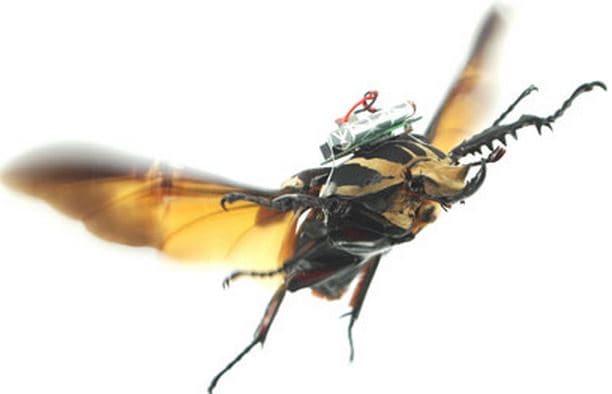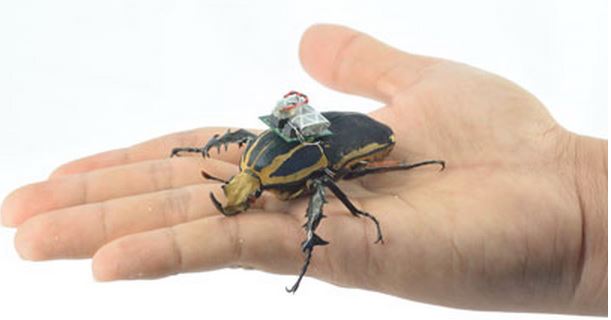Scientists fitted little transmitter backpacks to giant flower beetles and managed to control when they took off, landed, hovered in mid-air, and turned left and right while in flight. We are now one step closer to having fully-operational insect drones.
Engineers from the University of California, Berkeley, and Nanyang Technological University (NTU) in Singapore believe their technology could eventually lead to insects being sent into disaster zones as surveillance drones.
Their study, which involves hard-wiring beetles for radio-controlled flights, has also turned out to be an excellent way to learn more about their biology, giving scientists a better understanding of a muscle used by the insects for finely graded turns.

The ‘insect drones’ could be used for surveillance in areas too dangerous for humans. (Image: UC Berkeley)
By strapping tiny wireless radios and computers onto the beetles’ backs and recording neuromuscular data as the insects flew untethered, the researchers discovered that a muscle used for controlling the folding wings is also key for steering while flying.
They used that information to make more precise turns during their remote-control experiments.
Michel Maharbiz, an associate professor in UC Berkeley’s Department of Electrical Engineering and Computer Sciences, and colleagues published their findings in the academic journal Current Biology (citation below).
They believe their study showcases the potential of wireless sensors in biological research and search-and-rescue operations in areas too dangerous for humans.
Prof. Maharbiz, who was the study’s principal investigator, said:
“This is a demonstration of how tiny electronics can answer interesting, fundamental questions for the larger scientific community.”
“Biologists trying to record and study flying insects typically had to do so with the subject tethered. It had been unclear if tethering interfered with the insect’s natural flight motions.”

The researchers were able to remotely make the insects take off, turn left or right in flight, and even hover. (Image: UC Berkeley)
It had been especially difficult before to accurately determine the role that smaller muscles played in flight steering, the authors explained.
In this latest study, they found that the coleopteran third axillary sclerite (3Ax) muscle, located in the articulation of insect wings, plays a vital function in the beetle’s ability to veer and turn right or left.
Lead author Hirotaka Sato, an assistant professor at NTU’s School of Mechanical and Aerospace Engineering, explained:
“Since the 1800s, this coleopteran muscle was thought to function solely in wing folding. “Our wireless system allows us to record neuromuscular movements in natural, free flight, so we see now that this muscle is also used for turning.”

The beetle is 6 cm long and weighs 8 grams. The backpack weighs 1 to 1.5 grams. (Image: UC Berkeley)
Testing the steering muscle
Prof. Maharbiz and colleagues tested the muscle’s function by stimulating it during flight for graded turns that were significantly more controlled than previous versions of the cyborg beetle.
The giant flower beetle (Mecynorrhina torquata) has an average length of 6 centimeters and weighs of 8 grams – about as heavy as a one-dollar coin (or a British 50p coin).
The beetle’s backpack contains a minuscule, off-the-shelf microcontroller and a built-in wireless receiver plus transmitter. Six electrodes are connected to the insect’s optic lobes and flight muscles. The device is powered by a 3.9-vold micro lithium battery that weighs 1 to 1.5 grams.
Prof. Sato, who was at UC Berkeley as a postdoctoral researcher at the beginning of the study and continued on the project at NTU, said:
“Beetles are ideal study subjects because they can carry relatively heavy payloads. We could easily add a small microphone and thermal sensors for applications in search-and-rescue missions.”
“With this technology, we could safely explore areas not accessible before, such as the small nooks and crevices in a collapsed building.”
The beetle’s backpack received signals every millisecond during the test flights, which directed the insects to take off, turn right or left, and even hover while still in mid-flight.
The untethered beetles were in a closed room fitted with eight 3-D motion-capture cameras.
“In our earlier work using beetles in remote-controlled flight, we showed excellent control of flight initiation and cessation, but relatively crude control of steering during free flight.”
“Our findings about the flight muscle allowed us to demonstrate for the first time a higher level of control of free-flying beetles. It’s a great partnership between engineering and science.”
The study was funded by the US National Science Foundation, the Agency for Science, Technology and Research in Singapore, and the Nanyang Assistant Professorship (Singapore).
Citation: “Deciphering the Role of a Coleopteran Steering Muscle via Free Flight Stimulation,” Hirotaka Sato, Tat Thang Vo Doan, Svetoslav Kolev, Ngoc Anh Huynh, Chao Zhang, Travis L. Massey, Joshua van Kleef, Kazuo Ikeda, Pieter Abbeel, Michel M. Maharbiz. Current Biology, Volume 25, Issue 6, p798–803. Published 16 March, 2015. DOI: http://dx.doi.org/10.1016/j.cub.2015.01.051.
UC Berkeley Video – Remote-controlled beetle
